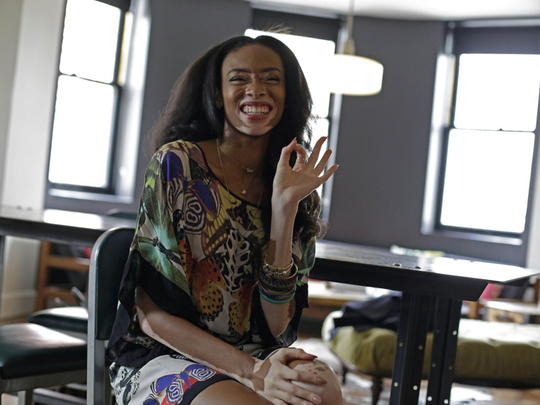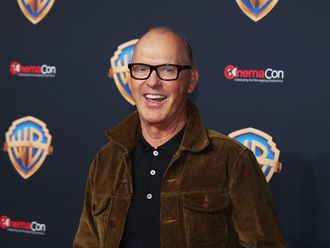
The morning I’m due to meet Chantelle Winnie, I’m at the doctor’s and mention I’m interviewing someone with the skin condition vitiligo. The doctor’s advice is to maintain eye contact throughout. Never let the eye wander towards her physical “abnormalities”. I had been prepared to ask Winnie what she thought of this, but within a minute of watching her in full-on model mode, under a blinding skylight designed to unleash the black-and-white marble tones of her body, it becomes obvious there is no need. It would be rude not to stare at her skin.
Winnie is, after all, a runway queen influenced by the walk of Naomi Campbell and the iconoclasm of Marilyn Monroe. She’s also a former contestant on US reality show America’s Next Top Model (ANTM), the new face of Desigual, and muse of famed photographer Nick Knight and London designer Ashish. Her skin condition has made her career and become a symbol for diversification and progression. As ANTM’s host Tyra Banks says: “The moment I laid eyes on Chantelle, I wanted her on Top Model. Her beauty is undeniable and her skin breaks down barriers of what is considered beautiful.” Yet it’s also an albatross. Marvel at the albatross all you want, but the more you remind Winnie of its presence the further it vexes her.
“This skin here is a white block,” says the photographer, pointing at Winnie’s abdomen. “You can’t see the difference in colour.” The way her plaited skirt is resting above her hips only flaunts the off-white of her stomach. More flesh is required to demonstrate the variations. Winnie obliges. She rearranges the skirt, glances down at her dainty arm against her abs, flips her hand back/forth, white/black, matching/contrasting. She works the camera more than your average model. She pivots, she glides, she gracefully topples sideways to the bass of Major Lazer’s Bubble Butt.
“My skin’s not a normal sight,” she explains later, separating some hummus from a pumpernickle sarnie. “When a photographer says: ‘I don’t know what it is, but that’s just not it...’ I know. They like the different colours of my skin. They’re not getting them with a particular outfit.”
Winnie is wearing delicate whites that won’t distract from her skin, the main event. It comes alive as she stretches her torso, showing off its unique markings beautifully. Winnie has been compared to a cheetah, which she doesn’t mind. She’s a Leo. Cheetahs are sexy.
She cares far less for “gorgeous cow” compliments. They remind her of being 13 and walking into the school auditorium where a bully led a chorus of “Moo! Moooooooooooo!” So unpleasant, but only marginally more so than the line in ANTM when a judge gasps: “Wow! You’re like an X-Man! But can you model?”
Winnie is an inspirational conversationalist. She wants to blow up the fashion world by adorning the cover of Vogue and walking for Chanel. She has a boss-a** and a businesslike handshake. Last November, she gave a TED Talk in which she concluded there’s no reason to fit into preordained moulds as “there is beauty in everything”. You want to believe she’ll have an illustrious career. Not only would that challenge a notoriously homogenous industry, it would also reward Winnie’s modelling talents, which she has in spades.
“If humans want to see the same types of people over and over that’s what industries will give us. If we want to see something different that’s what they’ll have to give us. People used to put me in a category with [albino models] Shaun Ross and Diandra Forrest. That is segregating. I don’t want to be put in a category.”
The thing Winnie can’t pinpoint so astutely is that vitiligo only gets her so far before it becomes a hindrance. Take her Instagram, for instance. Without it, she would never have caught the attention of Tyra Banks. Her community of 400,000 fans are there to ogle over her most compelling asset. Whether she likes it or not, she’s a walking advertisement for outsiderdom first, and a model for stuff second. Her skin is more striking than any product she could sell.
So every time I delve deeper into the subject of vitiligo, her answers become more opaque, her manner defensive. “I dropped out of school when I was 16, 17, I don’t recall.”
Winnie is 20. There are wounds there, a repressed anger.
Chantelle Brown Young was born to a single-mother hairdresser in Toronto. She tried her hand at everything: ballet, piano, journalism. Never modelling. She moved schools numerous times due to bullying and “altercations”. As her school attendance fell, modelling opportunities came to her. Her break arrived when local YouTube personality Shannon Boodram saw her Facebook pictures and asked to shoot her for a music video. For the first time she was celebrated for her looks. Requests to do editorial work came in despite her rejection from every agency in Toronto (she still isn’t represented today).
When Tyra Banks called, Winnie jacked in school for good and flew to LA faster than you can say: “Congratulations, you’re in the running towards becoming America’s Next Top Model.”
“People ask me: would you do it again? No. I want to be a model, not a reality star.” Chantelle was the second contestant eliminated. At the time she felt “stabbed in the back”.
Tyra Banks promotes diversity by blasting it into the homes of millions, but there’s also a crass exploitation there, which plays on a toxic cocktail of the contestants’ narcissism and vulnerability. Winnie’s particular TV “freak-show” factor was her vitiligo.
Celebrating her skin
She developed the autoimmune disease when she was four. Vitiligo affects 1 per cent of the population. It doesn’t discriminate against skin type or age and can attack any part of the body including eyes, hair and mouth, resulting in depigmentation patches.
Winnie has made a conscious decision to celebrate her skin as it is. There are “treatments”: UVA light therapy, skin dye, make-up, topical medicines, even surgery. They don’t interest her. Some vitiligo victims have spoken of their frustrations with Winnie. One woman expressed disappointment at Winnie’s promotion of a brand of foundation, furious that she’d wear anything besides mascara and lipstick. “Hold up. I don’t care what you do, this is what I do,” counters Winnie. “It’s my life. I’m very happy for whatever choice you want to make. Getting your eyebrows done, lip injections, a haircut, liposuction, that’s your choice. People think that because I’m so proud of my skin I stand for making no changes. I’m not for or against anything other than being happy.”
Winnie prepares for a days’ work with a few hours’ sleep, some Netflix, water and cans of Red Bull — which are peppered around her dressing room. On set she keeps herself occupied by flicking through her Instagram. “There are some diehard fans — my army. Some are artists who draw me over and over and over again. I love it.” She’s also a music nerd, distracted by Kyle, her manager/DJ, who plays Rihanna throughout the afternoon while Winnie mouths along. Her biggest inspiration outside fashion is the rap sensation Drake, who Instagrams a picture of himself hanging out with her several days after this interview.
“The whole OVO team [Drake’s record label] is so iconic. There’s no other group of people who were friends for so long and have built an empire off those friendships.”
Winnie’s best friends are her mother, her two sisters and Kyle, her manager, who never leaves her side. Although Winnie had never heard of Desigual or Ashish or Nick Knight when they contacted her, Kyle had. Her success less than a year after appearing on ANTM is unprecedented.
Ashish himself is unstinting in his praise: “Winnie’s unique look challenges perceptions of beauty in an industry obsessed with a kind of ‘perfection’ and a mainstream notion of what is beautiful or edgy,” he says. “Casting Winnie in the show made it so much more than just an issue about skin colour. It was about questioning stereotypes of models that we see on the runways, and about role models for young women. Her lack of representation, however, is not an act of defiance.
“I would love to be signed to an agency. I’ve brought myself very far, but with an agency backing me it would be easy sailing.”
She doesn’t want to be seen as just a “spokesmodel” for vitiligo. “If one day I’m all black I’m still a model. If one day I’m all white I’m still a model. I am not my skin. I am a model with a skin condition.”
Mistaken assumptions about Winnie’s vitiligo still dog her. “I get comments saying that I’m a leper, I control how my skin changes, I bleach my skin, my skin’s burned. None of those are true. The world is looking at me now. I either let the haters affect me or I step my money up. When I stand back from all the hate and I check my bank account... Hahahahaha.”
Winnie’s story is one of hope in a superficial industry — proof that our differences are cause for celebration on magazine covers — but it’s also one of frustration. Her biggest challenge is to get past what makes her different, to celebrate what makes her the same.
Before we part, one final question: what’s your favourite feature?
“My lips. I like my lips.”











